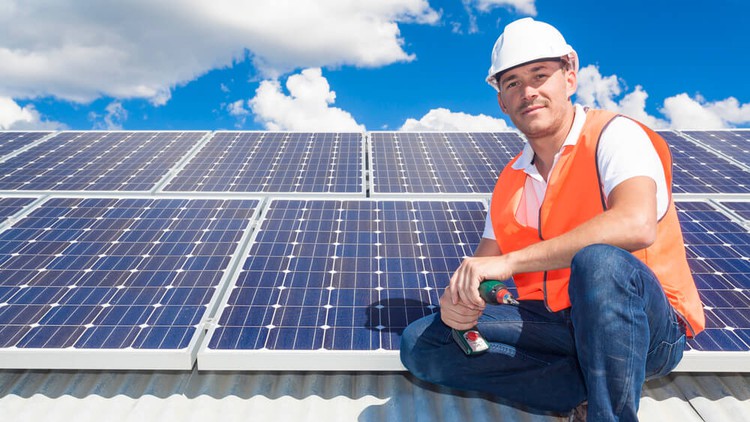1. Color of Earthing Cable
2. Color Scheme of the 120220 AC Split
3. Calculate Voltage in a Cable
4. Calculate System Power given Solar Irradiance and Module Power
5. Understanding Multimode Inverter
6. Understanding Sun Path Chart
7. Which type of System to install at home
8. Which Grounding System is used these days
9. Type of Mounting Method required for roof top
10. Difference between Inverter, Charge Controller, Transformer and Super Capacitor
11. What is PV Cable
12. Understanding OSHA
13. Understanding Transformers
14. Calculating least No of PV Modules for a System
15. Understanding Units of Solar Irradiance
16. Where is Grounding Point in support structure of PV array
17. Why Bypass Diodes are used
18. Different areas in IV Curve of a PV Module
19. Understanding change in PV Voltage due to temperature
20. Fuse rating of a PV Module
21. Difference between equipment of transmission, distribution and service equipment
22. Calculating mppt voltage given 4 No. of source circuits
23. Understand to Calculate Electrical Power
24. Understanding Voltage drop phenomenon in a cable
25. Understanding Sealed Batteries
26. Ground Fault detection by Inverter
27. Calculating System Size given two No of Source circuits
28. Who approves a PV System
29. Understanding and Calculating Cell Voltage of a PV Module
30. Understanding various tools for troubleshooting
31. Understanding effect due to undersized PV system
32. Understanding Mounting types for PV Modules
33. Recommended slop of the ladder as per OSHA
34. Safety concerns while working on an electrical system
35. Location where PV disconnect not allowed
36. Understanding most possible hazard while working on PV Systems
37. Understanding how current ca be effected in a PV Module
38. Calculating Electrical Energy Units (KWh)
39. Calculating Resistance in a Circuit
40. What is STC Standard
41. What is Direct PV application
42. Understanding specifications of a Charge Controller
43. What is Fall Protection as per OSHA
44. Requirements of Safety Net as per OSHA
45. Requirements of Stairways as per OSHA
46. Category of High Voltage Safety Hats
47. How much current passing through human body is dangerous
48. Safest way to find out the PV Output Current
49. Understanding MPPT
50. What insulation of a conductor represents
51. Calculating Annual Energy Yield of a System given specs
52. Safe way of handling PV modules on a roof
53. Safe way to test DC voltage of a PV Disconnect
54. Understanding effect of PV Modules connected in parallel
55. Troubleshooting Off-Grid PV system often shuts down during winter
56. Where Bypass Diodes are located
57. Who make requirements for electrical safety for Employees
58. Understanding Cable sizing
59. Understanding core component of a PV Module
60. Understanding Magnetic Declination
61. Who decides which standards to apply
62. Calculating Efficiency of the PV Module given rated power and size
63. Calculating Voltage drop between Battery and Charge Controller
64. Understanding Equinox
65. What happens if output terminals of a PV Module are shorted
66. What to do if stand-alone PV System designed hardly fulfil the Load requirements
67. Finding tilt angle of the PV Module for best summer performance
68. Suitable Tools to check and troubleshoot
69. What are requirements to replace faulty Inverter
70. Understanding Equalizing in Batteries
71. Requirement of heavy equipment Operator as per OSHA
72. Suitable instrument to measure the insulation resistance of a Cable
73. What is Residential Voltage scheme in US
74. Understanding the importance of ASHRAE in design of Solar PV Systems
75. Understanding requirements of MC4 connectors
76. Understanding PV Wire or cable for a PV Module
77. Finding suitbale location of an Inverter for a Farm land given site data
78. Understanding Interactive PV system
79. Selecting econimical PV Module for a site given cost and others
80. Prohibited area of installing Lead Acid Battery
81. Understanding Electrical Voltage
82. Understanding Hybrid System
83. Requirements of terminals of PV Module
84. Understanding Secondary Battery






